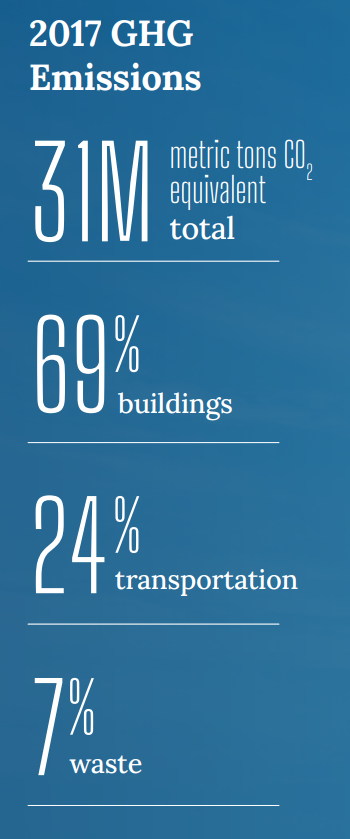Electrify Chicago
An independent tool for viewing City of Chicago building data
According to the
2022 Chicago Climate Action Plan,
69% of Chicago's emissions come from buildings, making
building emissions our biggest challenge and our biggest opportunity as a city
to tackle climate change. At Electrify Chicago, we showcase building performance using
publicly available data supplemented by community-submitted photographs and building
owners.
Start by looking at Chicago's buildings with the highest greenhouse gas intensity i.e. emissions per square foot. Large, efficient, buildings can perform much better than very inefficient small buildings on this metric.
New Article
📰 $30 Million In Missed Fines
The City Of Chicago failed to collect $30 million in potential fines from the building benchmarking ordinance, reducing transparency and accountability.
Legislative update! 🎉
As of late January 2024, legislation is being introduced to require new use more efficient forms of water and space heating, via the Clean And Affordable Buildings Ordinance (CABO), which will reduce the number of highly polluting and inefficient buildings that end up on this site.
If you're in Chicago,
write to your alderman to support the CABO!
Chicago Buildings by Greenhouse Gas Intensity
Note: Data includes large Chicago buildings with data from 2022, unless explicitly stated otherwise.
Note: This data only includes buildings whose emissions are reported
under the
Chicago Energy Benchmarking Ordinance. According to the City “As of 2016,
this list includes all commercial, institutional, and residential buildings larger than
50,000 square feet.” This dataset is also then filtered to only buildings with
reported emissions > 1,000 metric tons CO2 equivalent.
The latest year of data is from 2022, but we update the site regularly when new data is available, and some buildings may have failed to report that year, and only have older data available.
| Property Name / address | Primary Property Type |
Greenhouse Gas Intensity (kg CO2 eq./sqft) |
Total Greenhouse Emissions (metric tons CO2 eq.) |
|---|---|---|---|
|
AMLI River North
71 W Hubbard St
| Multifamily Housing | 5.7 kg/sqft
Lowest 37%
| 2,563 tons
Highest 17%
|
|
Windermere House
1642 E 56th St
| Multifamily Housing | 5.7 kg/sqft
Lowest 37%
| 2,031 tons
Highest 23%
|
|
Clinton Street Lofts
226 N Clinton St
| Multifamily Housing | 5.7 kg/sqft
Lowest 37%
| 790 tons
Lowest 45%
|
|
Seventy East
70 E Lake St
| Office | 5.7 kg/sqft
Lowest 37%
| 885 tons
Lowest 50%
|
|
Flat Iron Building
🕰️
1579 N. Milwaukee Avenue
| Office | 5.7 kg/sqft | 522 tons |
|
950 W MONROE ST
950 W MONROE ST
| Multifamily Housing | 5.7 kg/sqft
Lowest 37%
| 709 tons
Lowest 41%
|
|
170 W POLK ST
170 W POLK ST
| Multifamily Housing | 5.7 kg/sqft
Lowest 37%
| 832 tons
Lowest 48%
|
|
901 W MADISON
901 W MADISON
| Multifamily Housing | 5.7 kg/sqft
Lowest 37%
| 1,542 tons
Highest 30%
|
|
210 N GREEN ST
210 N GREEN ST
| Office | 5.7 kg/sqft
Lowest 37%
| 526 tons
Lowest 28%
|
|
Pershing Apartments
🕰️
(CHA)
3845 S STATE ST
| Multifamily Housing | 5.7 kg/sqft | 519 tons |
|
680 N GREEN ST
680 N GREEN ST
| Multifamily Housing | 5.7 kg/sqft
Lowest 37%
| 403 tons
Lowest 17%
|
|
7455 7469 N GREENVIEW AVE
7455 7469 N GREENVIEW AVE
| Multifamily Housing | 5.7 kg/sqft
Lowest 37%
| 293 tons
Lowest 8%
|
|
4200 N Marine Drive
4200 4212 N MARINE DR
| Multifamily Housing | 5.7 kg/sqft
Lowest 37%
| 648 tons
Lowest 37%
|
|
2740 W. Armitage
🕰️
2740 W ARMITAGE AVE
| Multifamily Housing | 5.7 kg/sqft | 326 tons |
|
3616-18 North Pine Grove Avenue
🕰️
3616-18 N. Pine Grove Ave.
| Multifamily Housing | 5.7 kg/sqft | 311 tons |
Data Source:
Chicago Energy Benchmarking Data
